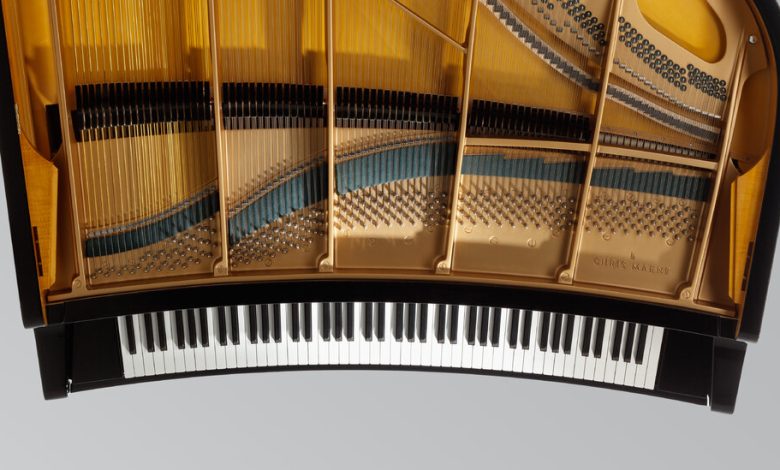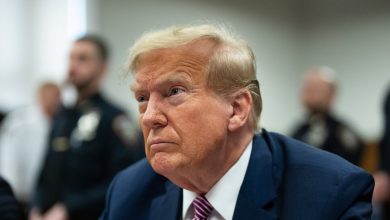A Piano With a Curved Keyboard Will Star at Carnegie Hall

Good morning. It’s Tuesday. We’ll find out about the unusual-looking piano that will make its Carnegie Hall debut tonight. We’ll also find out about a poll that went to big spenders, as the United States Tennis Association considers whether to build suites costing $175,000 per person at the U.S. Open.

Credit…Rafael Viñoly Architects
There’s something different about the piano that will be onstage at Carnegie Hall tonight. “It looks like you’re looking at a normal piano through funny mirrors,” according to Jonathan Biss, who will play Beethoven’s “Emperor” concerto on it.
The piano has a curved keyboard.
But it’s not a giant toy that a clown could bang on at the circus. Biss is no clown. Neither was the architect Rafael Viñoly, who came up with the idea and worked closely with Chris Maene, the instrument maker in Belgium who built the piano.
Viñoly, who died in March, was an advanced amateur pianist and wanted an instrument that would be more comfortable to play than a conventional one. The pianist Pam Goldberg tried it out with Bach and Liszt last week and said, “You feel like you’re enveloped in it.”
Wynona Wang, another pianist who tried the piano, said it was “magically more comfortable.” As she lit into a Tchaikovsky concerto, minus the orchestra, she said the reconfigured piano seemed smaller than a conventional one. Goldberg, by contrast, said that because of the curve, “it feels like there are more keys.”
There are not. The piano has the same 88 notes any other modern version has, from that very low A to that very high C. There is also a very high price tag — 465,000 euros, or about $509,000, according to Maene.
The Maene-Viñoly piano, as it is known, began with a dinner-party conversation among Viñoly and two old friends, the pianist Martha Argerich and the conductor and pianist Daniel Barenboim. Viñoly had studied the piano in his native Uruguay before becoming an architect. He owned at least eight grand pianos.
“When they were all sort of kvetching about how challenging the piano can be,” his son Roman Viñoly said, “he thought up this idea that it could be ergonomic. And if it was, the far reaches of the keyboard — the high end and the low end — could be brought closer to the pianist and relieve the physical contortions that are required on a regular piano.”
Roman Viñoly said that his father said something like, “What if the keyboard were curved?”
Argerich and Barenboim “looked at each other and smiled and said, ‘That would be great,’” Roman Viñoly said. “Their comment was flippant, but he took it to heart.”
Rafael Viñoly soon enlisted Maene, whose workshop is about 75 miles from Brussels, in Ruiselede. What had evolved in Viñoly’s mind was “a completely different model from other pianos,” Maene said. “The full shape of the instrument is the result of the curve.”
That meant changing more than the keyboard. The action — the complicated mechanism that drives the hammers to the strings, in response to the way the pianist touches the keys — had to be reconceived, to fan out at the angles indicated by the keys.
So did the strings and the soundboard. Roman Viñoly said the soundboard was 30 percent larger than one in a normal concert grand.
Maene and his team also had to rework the glossy black rim that the audience at Carnegie Hall will see from the side, as well as the lid. “We worked for days and days with different shapes for the lid,” Henk Swinnen, a product manager at the Maene firm, said, “and we made several models of the lid with different angles. We’d put it on and we’d take it off until we found the right shape.” The result serves to project the sound from the treble notes, he said.
The Maene-Viñoly piano ended up being more than a foot longer than, say, a Steinway concert grand: The piano is so large that when it arrived at Carnegie Hall last week, the instrument would not fit in an elevator but was wheeled into a space under the main stage where ladders and electrical equipment are stored. Tonight’s concert is a benefit for the Viñoly Foundation. Roman Viñoly, its board chairman, said he was looking to support architects as well as early childhood education, “to instill a critical understanding of the built environment” that his father had championed.
The piano is straight-strung — the bass strings do not cross over the treble strings, as they do in most modern pianos. Maene had built a straight-strung instrument for Barenboim; some pianists maintain that the straight-strung layout makes the sound more distinctive from one octave to the next. “The value of modern piano makers is evenness,” Biss told me. “One of the things a good Steinway can do is consistency of color from top to bottom.” A straight-strung piano “gives me a different color palette,” he said.
Biss said he had expected to spend time “trying to figure out how this thing worked.”
But in fact, he said, “it was effortless. It’s the kind of piano you instinctively want to play.”
Weather
It’s a mostly sunny day in the high 30s. The evening is mostly clear and breezy, with temperatures dropping to the high 20s.
ALTERNATE-SIDE PARKING
In effect until Dec. 8 (Immaculate Conception).
The latest New York news
-
Two men exonerated: Jabar Walker and Wayne Gardine, who were convicted in unrelated murder cases, became the latest in a long string of New Yorkers, overwhelmingly Black and Hispanic, who have had their names cleared after decades in prison.
-
A wave of sex-abuse lawsuits: More than 3,000 civil suits have been filed under the Adult Survivors Act, a state law that allowed victims to file sex-abuse lawsuits even after the statute of limitations had run out. Some of the lawsuits were aimed at politicians, others at institutions.
-
A new way for car crash victims to seek justice: Circles for Safe Streets, a program of the Center for Justice Innovation, encourages New York drivers who hit people to take responsibility. Those who were injured can speak directly to those at fault.
$175,000 for a ‘bunker suite’ at the U.S. Open?
A poll sent to people who had watched the U.S. Open from luxury suites tested their willingness to pay for even more expensive options at Arthur Ashe Stadium.
One possibility: so-called bunker suites set in the ground adjacent to the main court. Access could cost as much as $175,000 for one person during the two-week tournament.
My colleague David Waldstein writes that enhancing high-paying attendees’ already lavish experience with even more luxury would widen the gap between the celebrities and hedge fund moguls in luxury suites and the subway-riding fans in the top rows.
Tournament officials say that Ashe, which opened in 1997, is showing its age. They hope to refurbish the stadium, taking a page from Madison Square Garden’s billion-dollar upgrade that was completed in 2013. The bunker suites at The Garden are considered its most exclusive jaw-dropping experience.
The poll, an online survey sent to 15,000 people, asked about luxury options under consideration. For example: For access to a proposed Rackets Club, would a fan be more likely to pay $3,700 per person for a single-day session or $93,000 for the entire tournament?
Daniel Zausner, the chief operating officer for the tennis center, said that whatever renovation takes place will not affect the more affordable seating at the top of Ashe.
METROPOLITAN diary
Crying in public
Dear Diary:
Crying in public is one of my favorite New York experiences. I’ll shed a tear on the subway when I hear a certain song or read a line from a book that moves me.
I have sobbed on the steps of Union Square station over boys and jobs. It’s so cathartic. As I cry, life goes on around me, reminding me that my tears are small fry and temporary.
Once, I ran into my ex- boyfriend exactly three months after we broke up. He was coming out of the Beverley Road Q station as I was going in.
We both stopped in our tracks. I watched his face crumple.
“Can I give you a hug?” he asked.
I nodded.
We held each other and cried for just a minute while people swarmed around us. We said we missed each other.
The woman we used to buy tamales from watched us. Maybe she could guess what had happened.
I heard the train below us, and we broke apart.
“Have a good day, sweetie,” he said.
That old term of endearment rang in my ears as I stood on the platform crying.
An old woman smiled at me. A child looked at me curiously. Life went on.
— Divya Bharadwaj
Illustrated by Agnes Lee. Send submissions here and read more Metropolitan Diary here.
Glad we could get together here. See you tomorrow. — J.B.
P.S. Here’s today’s Mini Crossword and Spelling Bee. You can find all our puzzles here.
Melissa Guerrero and Ed Shanahan contributed to New York Today. You can reach the team at [email protected].
.



